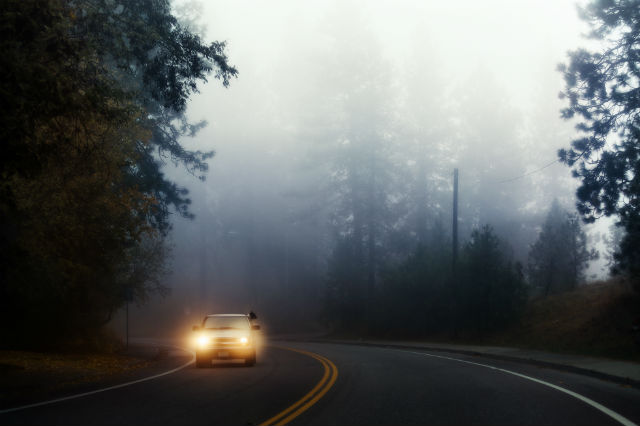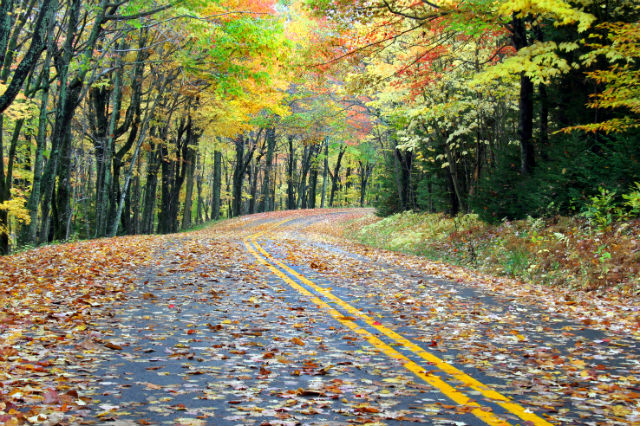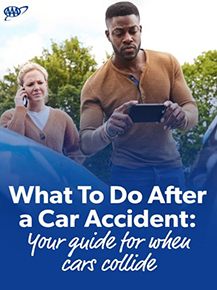Each year, the transition from summer to autumn brings the much-anticipated return of colorful foliage, sweater weather, football season and all things pumpkin. However, the beginning of fall also comes with potential driving risks, including slippery roads, decreased daylight, fog and sun glare. Autumn weather can be unpredictable and conditions can change drastically within a matter of minutes.
Prepare yourself and your vehicle for the changing seasons with the following tips to help you drive safely in the fall.
How to Drive Safely in Darkness
As the days get shorter, you will likely be driving in the dark more.
- Be sure to keep your headlights clean and in proper working order; dim or misaligned headlights can decrease your visibility.
- Always watch for pedestrians walking, jogging or biking through the streets; they may be difficult to see at night if they are wearing dark clothing.
- Be mindful of children walking to and from bus stops in the morning and afternoon.
- Fall is also an active breeding time for deer, so travel slowly if you live in a deer-laden area. If you see a deer cross the roadway, expect others to follow, as they often travel in groups.
Cold Weather
- Fall weather can change rapidly from warm to cold, causing roads to ice over overnight. Drive slowly and brake gently when driving across overpasses and bridges, as these surfaces tend to frost over before others. Be aware of spots where black ice forms on the roadway and drive carefully through these areas.
- Check your tire pressure daily. Extreme changes in temperature will cause your tires to expand and contract, which may lead to a loss of tire pressure. Before starting your vehicle, clear away any frost on your windows and check that your tires are properly inflated and have plenty of tread.

Driving in Fog
With cold autumn mornings often comes fog.
- When driving in foggy weather, set your headlights to low instead of high. High-beam headlights bounce off of fog and reflect back at you, further impairing your ability to see the road. Low beams, however, aim down toward the roadway and improve your visibility.
- Slow down and leave plenty of space between you and the car in front of you so that you have ample time to stop if necessary.
Glare
Autumn’s sunrises and sunsets can cause a large amount of glare, making it difficult to see other vehicles, pedestrians, traffic lights or the roadway.
- To combat glare, clean your windshield inside and out to remove any dust particles, streaks or smudges. These can become magnified when illuminated by sunlight and impact your visibility.
- Avoid using washing and waxing products that increase your car’s shine. These products magnify the sun’s glare on your car, which may cause the light to reflect into your eyes and blind you for a few seconds.
- Keep a pair of sunglasses in your vehicle at all times to protect your eyes from the sun’s rays. If you frequently drive at night, consider purchasing lenses with anti-reflective coating in order to reduce glare from streetlights and headlights.

Wet Conditions
Fall is notorious for wet weather. Wet leaves pose a risk to motorists since driving on them is like driving on ice.
- Before starting your car, remove any leaves from your windshield to prevent them from getting stuck under your wiper blades. Also, be sure to replace windshield wiper blades if they show any signs of wear. Neglecting your wipers can limit your vision during poor weather conditions and leave you in a dangerous situation.
- When driving during heavy rain, slow down, especially around turns. Wet conditions increase the time it takes your vehicle to come to a complete stop, so keep a good distance between you and the vehicle in front of you.
- Avoid sudden movements with the steering wheel or slamming on the brake pedal, as these actions may cause your car to hydroplane. If you feel that you are losing control of your vehicle, steer straight and gently release the gas pedal until you feel the tires make contact with the road surface again.
More Fall Driving Tips
- Never park your vehicle over a pile of leaves. Doing so may cause a fire to start from your vehicle’s exhaust system or catalytic converter.
- Never drive over a pile of leaves; small children often play in leaf piles.
- Changing temperatures and weather conditions create potholes, and leaves on the roadway may make it difficult to see them. Always be sure to slow down and avoid driving over leaf-covered areas, if possible.
- Check that your spare tire is correctly inflated and has a proper tread. Having an under-inflated spare could leave you stranded if you happen to get a flat.
Whenever you need a hand the road, AAA Roadside Assistance is available 24/7. For help after a crash, be prepared with car insurance through AAA Insurance.
AAA members can save on automotive replacement parts and accessories at NAPA.
One Thought on “Fall Driving Tips”
Leave A Comment
Comments are subject to moderation and may or may not be published at the editor’s discretion. Only comments that are relevant to the article and add value to the Your AAA community will be considered. Comments may be edited for clarity and length.
















These are excellent suggestions! There is a lot to think about when driving during seasonal changes in weather. The biggest safety violations I have noticed on the road are:
(1) Speeding – this is an ongoing problem. Some drivers exceed the limit by 15-20 mph or higher on highways that are set to 55 or 65 mph or twisty suburban roads that are set at 40 or 45 mph where deer and other wildlife are plentiful, even during inclement weather and nightfall.
(2) Tailgating – this is a constant and serious problem. Some drivers might simply be careless and not paying attention; others tailgate to intimidate drivers to either accelerate or pull over to accommodate them. They will flash their brights and even honk their horns. Often the driver being tailgated cannot pull over and does not wish to accelerate, especially on unfamiliar roads or in bad weather.
(3) Walkers and hikers on roadways and streets that walk at night with their backs to traffic (wrong side of road for walkers) that wear dark clothing with no reflective accessories, and who are walking their dogs with no reflective collars or leashes.
(4) Drivers who do not use their turn signals when changing lanes, turning onto exit ramps or making right or left turns off of thoroughfares.
Some drivers must pay more attention to their driving and others should stop their intimidation and entitlement of the road. In addition, those drivers who have an emergency should either call an ambulance or the police to drive them or the affected party rather than driving themselves.